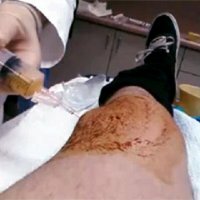Treatment of ankle fracture

In the treatment of fractures such parts as the ankle are used conservatively or operatively. What to apply - a gypsum or an operative measure? The answer to the question always depends on the type of fracture( treatment of an ankle with a fracture with a bias or a fracture without displacement), also from the experience of an orthopedic traumatologist and the possibility of rehabilitation( physiotherapy, physiotherapy exercises).
Conservative treatment of fracture of this part of the lower limb
With the isolated fracture of one of the ankles( fracture of the inner ankle or fracture of the external ankle) without displacement or with subcutaneous injury of the ligaments of the ankle joint, the following treatment is standard treatment. In the deep posterior gypsum longus, the limb is fixed to the very tips of the fingers. The patient in such a gypsum longus should stay for 4-6 weeks, not relying on a damaged limb. Treatment of a fracture with a shift involves the simultaneous correction, usually under local or general anesthesia, followed by fixation to the upper third of the tibia by a plaster dressing.
Immediately after repositioning, and also after a week( when the edema subsides), the control radiographs of the foot in the plaster bandage are made. If the condition of the fragments is normal, then leave the plaster bandage for 2-2.5 months. It depends on the severity of the ankle fracture, but without the load of the injured limb. After treatment of such a fracture, walking on crutches during the whole period of immobilization is prescribed.
In case of a large fracture in the fracture and a strong dislocation is present in the patient, the specialists draw the hose and insert the needles. On the hood, the victim lies for 4-5 weeks, without getting out of bed. Then, after a specified time, a repeated X-ray of the foot is made, a plaster is applied and a snapshot is taken again. In such cases, the disability of patients can be delayed for up to 6 months.
Conservative treatment of ankle fractures with displacement has certain drawbacks. This is a significant percentage of the displacement of fragments after the edema subsides. To the loss of bone mass, with the gradual development of osteoporosis, there is no load( axial) on the limb. As a result of edema, the supply of soft tissues is disrupted, which can prevent the normal fusion of the fracture. The disadvantage of such treatment is also the lack of the possibility of correction of subluxation in the ankle joint and a long period of rehabilitation of the patient after removal of gypsum. In rehabilitation for the treatment of fractures of the ankles, therapeutic exercises and physiotherapy are used. This is necessary for the development of all atrophied muscles, for restoring blood circulation to the extremities.
Treatment of the ankle with fracture by the operative method
Surgical treatment of the fracture is indicated for difficultly reponfected, uncontrolled, easily displaced and poorly retained ankle fractures. The operation is necessary for old, unattached fractures of the ankles, in all cases when attempts to fix a fresh fracture fail, and also if there are pronounced violations of statics and function, with pain in the ankle joint. Surgical intervention should be done 2-5 days after injury. Hematoma and edema do not serve as a contraindication to surgery.
The operation is performed under intraosseous or general anesthesia. After osteosynthesis and sewing, local antibiotics are administered and a plaster bandage is applied. If swelling builds up, the gypsum bandage is dissected. A day later, the wound is sewn up and an alcohol bandage is applied. Treatment of the wound is carried out regularly. In most cases, if the treatment passes normally, after 3-4 weeks after the surgery, this bandage is shifted to the time, usual for fractures, which are treated conservatively. After the plaster bandage is removed, it is necessary to undergo a rehabilitation course. This is physiotherapy, therapeutic gymnastics, wearing of the instep, orthopedic shoes.
If the treatment of the ankle in the fracture was not performed correctly and if the subluxation of the joint is preserved after the injury, also with an improper removal of the fragments, the patient may develop arthrosis of the ankle joint.



